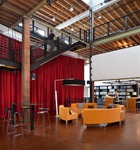RFM OFFICE & STUDIO
architect
Rice Fergus Miller
client
Rice Fergus Miller
location
Bremerton, WA
size
39,000 square feet
completed
2011
website
rfmarch.com
When Rice Fergus Miller Architecture and Planning (RFM) renovated a long-vacant building for its new office in downtown Bremerton, Washington, experimentation was a strong guiding principle. As the firm’s team explored the possibility of achieving net zero and pushing sustainability levels to the max, it still allowed the original structure of the building to suggest the direction of the design. The result, with its innovative mechanical system and LEED Platinum rating, might be considered a “screaming example of energy efficiency,” as founding partner Steve Rice puts it, and the many lessons learned along the way are already being applied by the firm to new projects in its key sectors of senior housing, healthcare facilities, fire- and emergency-service structures, and community projects. Jeremy Southerland, the lead project designer for the new office, took gb&d through a few of those lessons.
site/
The town of Bremerton had its heyday back in the 1940s, with a population of 85,000 as compared to 36,000 currently. However, during the last decade, much has been done to revitalize the downtown area, and RFM became part of that effort when it chose to rescue the Sears Allstate automotive-service store, which had been built in 1948 and had lain vacant for 24 years. “I cannot think of a single developer who wouldn’t have torn it down,” Southerland says, adding that the firm allowed the old and raw sections of the 39,000-square-foot building to remain just as they were, “creating a visual juxtaposition of new and old that encapsulates the whole project.” The office, consisting of two floors and a mezzanine level, lies just four blocks from a bus transit hub and a ferry terminal, which is important for the firm’s employees who commute from Seattle.

RFM left many of the structure's original materials exposed and raw, including the wooden support beams in the ceiling. In the kitchen, long rows of windows keep the area well lit. Photo: William P. Wright.

A crank opens the LEED Platinum building’s operable windows, allowing RFM to heat and cool the building naturally on pleasant days. Photo: William P. Wright.
energy/
One of the firm’s goals for the new office was to reach net-zero status, a first for RFM, though it knew getting there wouldn’t be immediately affordable. “We approached the design completely backward from an energy-performance standpoint, asking ourselves, ‘If we covered every surface of the building with solar panels, how much energy could be created?’” Southerland says. “Then we set that aggressive goal for ourselves.” The firm’s new office consumes about one quarter of the energy of a typical office building, with an EUI rating of about 19, and its rooftop solar array will produce approximately seven percent of the building’s annual energy needs.
water/
The building has two 3,000-gallon cisterns that will collect rainwater and ultimately save about 62,000 gallons of water each year. The water will be used for toilet and urinal flushing and also for irrigating a green roof and a small, planted area in front of the office. “It’s not a huge money saver, and it doesn’t pay off for a long time, but it makes tremendous sense and wasn’t a big investment,” Rice says. The building is also furnished with dual-flush toilets and low-flow urinals and showerheads.

The office uses operable clerestory windows and a fan from Big Ass Fans to create a chimney effect that keeps the space cool. Photo: William P. Wright.
mechanical system/
Southerland is reluctant to even call the office’s mechanical system mechanical. To ventilate the building, a large atrium was built in the center of the office to create a chimney effect. In lieu of ductwork, the office relies on variable-speed ductless heat pumps throughout the building to distribute localized heat and cooling to individual spaces. The exterior skin is super-insulated so that the system is dependent on outdoor air temperature instead of indoor air temperature—and also dependent on the firm’s employees. The firm spent a dollar extra per square foot to install this system, which will pay for itself in one year. “A huge portion of the year, we will use no energy to heat or cool the air, relying only on operable windows,” Southerland says. “We close windows to keep heat in the building, and as we are exhausting air out, we are bringing air in. If we get over 75 degrees Fahrenheit outside, we close the windows and use heat-recovery ventilators.”
community/
Instead of relocating to the next large town, as many local businesses have done, Rice says his firm built in downtown Bremerton to reinvest in its own community. In the spirit of the firm’s long commitment to “supporting the community that supports us,” the new office has become an offsite teaching tool for local university students who monitor the building’s performance data. And the office’s entry-level floor space has become a gathering place for community events, fundraisers, and nonprofit board meetings.

